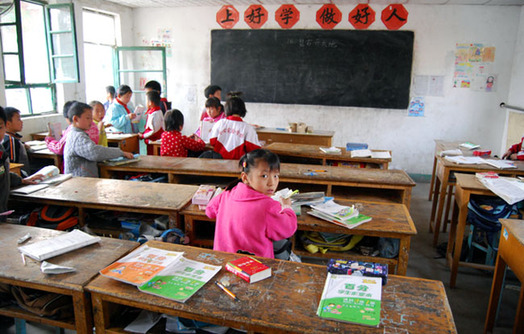Migrant children miss out on school coverage
- By Richard de Grijs
 0 Comment(s)
0 Comment(s) Print
Print E-mail China.org.cn, April 13, 2017
E-mail China.org.cn, April 13, 2017
|
|
|
A classroom at Tongxin Experimental School in Picun, a village near Beijing's Capital Airport. The slogan above the blackboard reads "study hard, become a good person". [John Sexton/China.org.cn] |
The stated target of 90 percent coverage by 2020, an increase of 2.5 percent from 2016, aims at providing opportunities for talented youngsters in China's rural western regions, facilitating a more level playing field with respect to that enjoyed by their more affluent counterparts in the nation's large cities in the east.
This initiative appears to form an integral part of the government's policy to reduce the pressure in the country's major population centers, encouraging residents without an official urban household registration, or hukou, to leave the overpopulated first-tier cities for greener pastures elsewhere.
Yet, a fact of modern life in the rapidly developing urban centers is that continued development requires manpower. Life would grind to a halt if the majority of workers in low-skilled jobs – motorcycle couriers, restaurant staff, cleaners, construction workers – would leave for less expensive living quarters in the country's interior.
Despite the government's well-meaning efforts, migrant workers are probably here to stay for the foreseeable future. But many face impossible personal choices, particularly regarding to their children's education. Instead of leaving their offspring behind, many choose to take their families along on their journey seeking a better life.
Yet, without urban hukous, they are ineligible to send their children to the public schools in the cities. The major cities simply don't have the resources to accommodate the huge annual influx of children from migrant families without compromising on educational quality.
These children are forced to join the end of the line. They are only allowed to attend public schools if space permits, and then often only after paying substantial out-of-district tuition fees, money most of their parents can ill afford -– despite the fact that new, tighter regulations in Beijing for example have resulted in many migrant parents paying into the city's social security system in the last few years.
It is therefore not surprising that many migrant parents opt to send their children to privately run schools set up in their local communities, which often charge lower fees but which may not offer the same level of education quality as the much better-resourced public schools.
Figures are hard to come by, but to give an idea of the scale of the problem, according to a study based on information from the All China Women's Federation and published by the Financial Times last year, in 2010 there were 35.8 million migrant children in China, up by 41 percent compared with 2005. Of those, 16 million were of secondary-school age.
According to the Beijing Municipal Commission of Education, the capital's school population in 2015 included 470,800 migrant children and 647,200 children in the possession of local hukous. In other words, more than 40 percent of the school-aged children attending the first nine years of Beijing's public schools were not officially registered in the capital.
Although these numbers may seem large, they represent a mere fraction of the total number of migrant children in Beijing. The most recent figures available indicate that in 2008, some 20 million migrant children were living with their parents in China's first- and second-tier cities. In Beijing alone, an academic study led by scholars at Stanford University found that in 2014, there were 230 well-established schools for migrant children.
I know from experience that these schools are often bare-bones institutions, with few of the educational resources that are much more abundantly available at their public-school counterparts, even in remote western areas. A few years ago, my colleagues and I traveled to remote Sichuan to engage the local secondary-school population in hands-on physics education.
Although we brought extensive kits with us as a gift to the local school district, we soon learned that our materials were superfluous to their needs; instead of resources, they rather needed experience in modern, hands-on teaching methods.
Yet, at the schools for migrant children in Beijing which my students and I visit on a monthly basis to offer "Fun with Physics" days, jointly with the Migrant Children's Foundation (MCF), materials are among the resources most needed.
Our efforts to provide an appreciation of scientific thinking to children from migrant families merely scratches the surface. Although the MCF is increasingly working with students from both local universities and international schools, the scale of the education problem is too large for just a voluntary effort to make a lasting impact.
Mass migration from the rural western areas to the affluent eastern cities will likely remain a fact of life for decades to come. Educational authorities would certainly welcome more resources to foster hidden talent among the largely ignored community of migrant workers.
Richard de Grijs is a columnist with China.org.cn. For more information please visit:
http://www.ccgp-fushun.com/opinion/RicharddeGrijs.htm
Opinion articles reflect the views of their authors, not necessarily those of China.org.cn.






